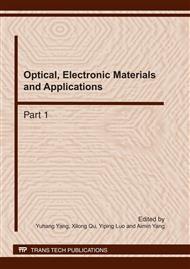p.364
p.368
p.373
p.378
p.383
p.388
p.393
p.397
p.402
A Study on Orthogonal Experiments of YAG: Ce3+ Yellow Phosphor for White LED
Abstract:
The YAG yellow phosphor was synthesized by Co-precipitation Method and its luminescent properties were characterized. The Orthogonal Experiment results that under laboratory conditions, the prepared phosphor luminous intensity reached at the maximum and the optical properties of compound as white up to the best with blue-chip, when calcinations temperature up to 1600°C, sintering time is 3h, the Ce3+content is 0.05.Therefore, the phosphor could provide a theoretical basis for the design and development of white LED with luminescent materials, promoting the practical of white LED.
Info:
Periodical:
Pages:
383-387
Citation:
Online since:
March 2011
Authors:
Keywords:
Price:
Сopyright:
© 2011 Trans Tech Publications Ltd. All Rights Reserved
Share:
Citation:


